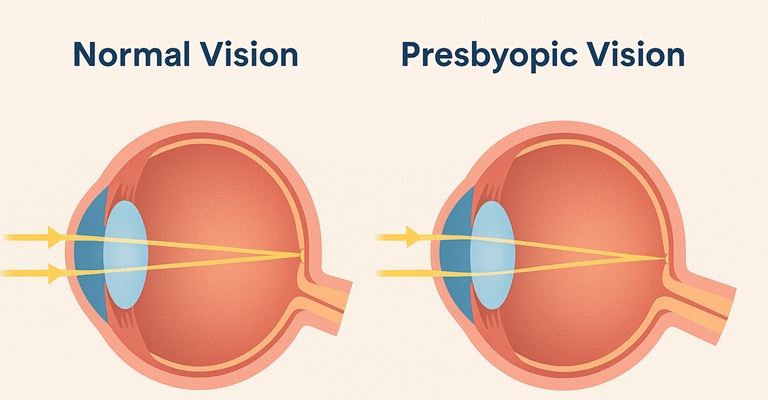Presbyopia meaning “old eye”
Presbyopia comes from a Greek word meaning “old eye” and represents a natural part of ageing rather than a disease. This vision condition happens when your eye’s lens loses its flexibility over time. This makes it harder to focus on things up close.

Age-related onset: typically after 40
People usually notice presbyopia between ages 40-45. Most studies use age 40 as a starting point, but people complain about it most between ages 42-44. By 45, most people need reading glasses. A study shows that more than one billion people worldwide had presbyopia in 2005, and this number could reach nearly 2 billion by 2050. About 25% of people worldwide (1.8 billion) had presbyopia in 2015.
Your eyeglass prescription might need more frequent changes as presbyopia gets worse. These changes usually continue until around age 60, when vision tends to stay stable.
Difference between presbyopia and farsightedness
Presbyopia and farsightedness (hyperopia) might seem alike, but they’re quite different conditions. Both make it hard to see things up close, but they happen for very different reasons.
People with farsightedness have an irregularly-shaped eyeball that stops light from properly hitting the retina. So close objects look blurry. Presbyopia happens because age changes your eye’s lens and supporting muscles.
There’s another reason they’re different: hyperopia can start during childhood and often runs in families, but presbyopia affects everyone as they age. On top of that, people can be born with farsightedness, but presbyopia only shows up in middle age.
Presbyopia in the eye: lens function explained
Let’s get into how the lens works to understand presbyopia better. Young eyes have a flexible and elastic lens. The lens stays relatively flat when looking at distant objects. The ciliary muscles contract to make the lens rounder when looking at nearby objects, which increases its focusing power.
The lens gets harder and less flexible with age. This happens because lens protein keeps building up throughout life, making the lens denser and stiffer. The ciliary muscles still work fine, but they can’t change the lens shape to work properly. Your eye doesn’t focus light well on the retina when looking at close objects. This explains why holding reading materials farther away helps for a while – it makes up for your ageing lens’s reduced focusing power.
The Eye Lens Changes with Age
The human eye’s structure changes remarkably as we age. These changes affect the crystalline lens and its surrounding structures. This explains why presbyopia becomes unavoidable at the time we cross our fourth decade of life.
Loss of lens elasticity after 40
The biggest problem with ageing eyes involves the progressive hardening of the crystalline lens. The hardening process starts early in life but becomes noticeable at the time we reach 40. The lens never sheds cells, unlike other body tissues. New layers of cells form continuously throughout life and create an “onion-like” structure that keeps the oldest cells at the center. This continuous growth makes the lens thicker and substantially less flexible as time passes.
Scientists have found a progressive decrease in the concentration of alpha-crystallin in human lens nuclei as we age. This protein’s changes match a dramatic increase in the lens’s stiffness, especially when you have reached middle age. These alterations affect the lens’s knowing how to change shape while focusing on nearby objects.
Reduced accommodation ability of the eye
The eye’s knowing how to adjust focus automatically from distant to near objects declines steadily with age. A nearly linear pattern shows this decline, and the subjective amplitude of accommodation drops to a minimum value of 1.00 to 2.00 diopters by age 55.
Several measurable changes demonstrate the gradual loss of accommodation. These include decreased magnitude of accommodation, longer reaction time, and slower peak velocity at the time we change focus. The lens resists shape changes needed for near vision more strongly, which leads to classic presbyopia symptoms.
Role of the ciliary muscle in Presbyopia meaning “old eye”
The ciliary muscle doesn’t weaken with age as previously thought. In stark comparison to this, it develops compensatory hypertrophy, with contraction force about 50% stronger at the time presbyopia begins than in youth. This adaptation tries to overcome the hardened lens’s increased resistance.
A properly functioning ciliary muscle contracts and reduces tension on the lens’s zonular fibres, allowing a more spherical shape for near vision. The hardened lens can’t change shape enough despite this increased muscular effort. Recent studies show the ciliary muscle stays functional even in advanced age, which supports a theory that presbyopia mainly stems from lens-related issues.
Common Presbyopia Symptoms
Spotting presbyopia symptoms early helps you get the right treatment before they start affecting your daily life. These symptoms usually show up gradually after 40. They get worse over time but level off around age 65.

Blurry vision when reading up close
The main sign of presbyopia shows up as blurred vision at normal reading distance (about 35cm). Your eye’s lens becomes stiffer and can’t focus light properly on the retina for nearby objects. You might first notice this blur while reading books, looking at your phone, or viewing computer screens. Many people realize something’s wrong when text messages or newspaper print become unclear, even though they can see things far away just fine.
Eye strain and headaches during near tasks
People with presbyopia often get eye strain, discomfort, and headaches after reading or doing close-up work for a while. Your eyes have to work harder because they can’t focus as well, which leads to tiredness. You might catch yourself squinting or rubbing your eyes during tasks that used to be easy. This eye fatigue gets worse throughout the day, especially after you’ve been concentrating for long periods.
Holding reading material farther away
The most obvious sign of presbyopia is how people naturally hold things at arm’s length to read them. This helps them see better by putting more distance between their eyes and the text. Your friends or family often notice this habit before you do. If you’ve started holding menus or ingredient labels further away to read them, you probably have developing presbyopia.
Difficulty seeing in dim light
As presbyopia gets worse, you’ll need much brighter light for close-up tasks. Reading becomes tough in low light because dim conditions make your already compromised near vision even worse. You might notice this when you can’t read restaurant menus in soft lighting, or you need extra light for bedtime reading.
Presbyopia Treatment Options Explained
Today’s presbyopia patients have several treatment options that help maintain clear vision at all distances. Here are the most common solutions:
Over-the-counter reading glasses
Ready readers are an affordable way to deal with presbyopia. You can get them without a prescription in strengths ranging from +0.75 to +3.50 diopters. These glasses help people who can’t see things clearly up close due to presbyopia. They’re convenient and cost less, but both lenses have the same magnification. This makes them unsuitable for people who have different vision strengths in each eye. You should ask an optometrist about the right magnification level before buying these glasses.
Prescription bifocals and progressive lenses
Bifocal lenses work well for people who need different prescriptions for distance and near vision. The top part helps with distance vision, and the bottom part helps with near vision. Progressive lenses provide smooth transitions between different lens powers without visible lines. You can choose from three types: standard progressive lenses with large near vision areas, premium progressive lenses with wider viewing areas and fewer distortions, and custom-designed premium progressive lenses that match your specific needs.
Multifocal and monovision contact lenses
Multifocal contact lenses pack multiple prescriptions into one lens. This lets you focus at different distances without glasses. The designs include concentric lenses with distinct rings of near and distant powers, and aspheric lenses where power changes gradually from centre to edge. Another option is monovision, which corrects one eye for distance and the other for near vision. Research shows 51-76% of patients prefer multifocal lenses over monovision.
Eye surgery for presbyopia: LASIK and corneal inlays
LASIK surgery can create monovision or blended vision. Corneal inlays are less common now but involve tiny devices placed in the cornea to improve near vision. The KAMRA inlay, previously FDA-approved, used small-aperture optics to increase focus depth. Current research looks at allograph inlays that use actual corneal tissue instead of synthetic materials.
Pilocarpine eye drops for temporary correction
Can’t read the fine print? Modern treatments can restore your near vision clarity. FDA-approved pilocarpine eye drops like VUITY (1.25%) offer temporary presbyopia relief. These drops make your pupils smaller to improve near vision for 4-8 hours without affecting distance vision. A study showed about 30% of patients gained three or more lines of binocular distance-corrected near visual acuity. Most patients use one drop in each eye daily, with the option to add a second drop 3-6 hours later Consult a doctor before use.
Conclusion for Presbyopia meaning “old eye”
Presbyopia affects almost everyone over 40 as a natural part of ageing. The eye’s crystalline lens becomes less flexible with age and makes focusing on close objects harder. While we can’t prevent this condition, many solutions exist to manage its symptoms.
Patients need to know how presbyopia differs from other vision problems. The condition stems from the eye lens hardening with age, unlike farsightedness which happens due to an irregularly-shaped eyeball. People who struggle to read up close, experience eye strain, or hold books at arm’s length should see an eye care professional.
Treatment choices have grown substantially over the last several years. Simple reading glasses, advanced multifocal contact lenses – these options let you pick what works best for your lifestyle and vision needs. LASIK surgery offers a more permanent fix, while pilocarpine eye drops can provide temporary relief without affecting your distance vision.
Without doubt, catching presbyopia symptoms early helps minimize disruption to your daily life. Eye exams become crucial after 40. They let your eye doctor track changes and update prescriptions as needed. Presbyopia shouldn’t stop you from having clear vision throughout life. It’s a natural change that you can manage well with the right approach. Clear vision helps maintain your quality of life, efficiency, and independence at any age.
- Sleeplessness (insomnia)
- Furuncle Nostril
- Presbyopia meaning “old eye”
- Oral cancer
- Gestational Trophoblastic Neoplasia (GTN)
Acne Acne vulgaris Acute Renal Failure Adrenal cortex Angina Angina Pectoris Aortic Regurgitation (AR) Aortic Stenosis (AS) Chest pain Chronic pyelonephritis Coarctation of Aorta Cough cyanosis Cystic acne Dehydration depression Diabetes Mellitus Diagnosis of Aortic Stenosis Dr.KTS DR K TAMILSELVAN Fatigue Heart Failure Hypertension Hypokalemia Hypothyroidism Ischemic Heart Disease LBBB Mitral Incompetence Mitral insufficiency Mitral valve prolapse Nocturia Patent Ductus Arteriosus PDA Polyuria Proteinuria pulmonary hypertension Pulmonary Stenosis ST Depression Symptoms of Acne Syncope Treatment for acne valvular heart disease Ventricular Septal Defect VSD Zits
medlight2u.com
A light on Practice of Medicine (The information provided is for informational and educational purposes only and should not be considered professional advice)

